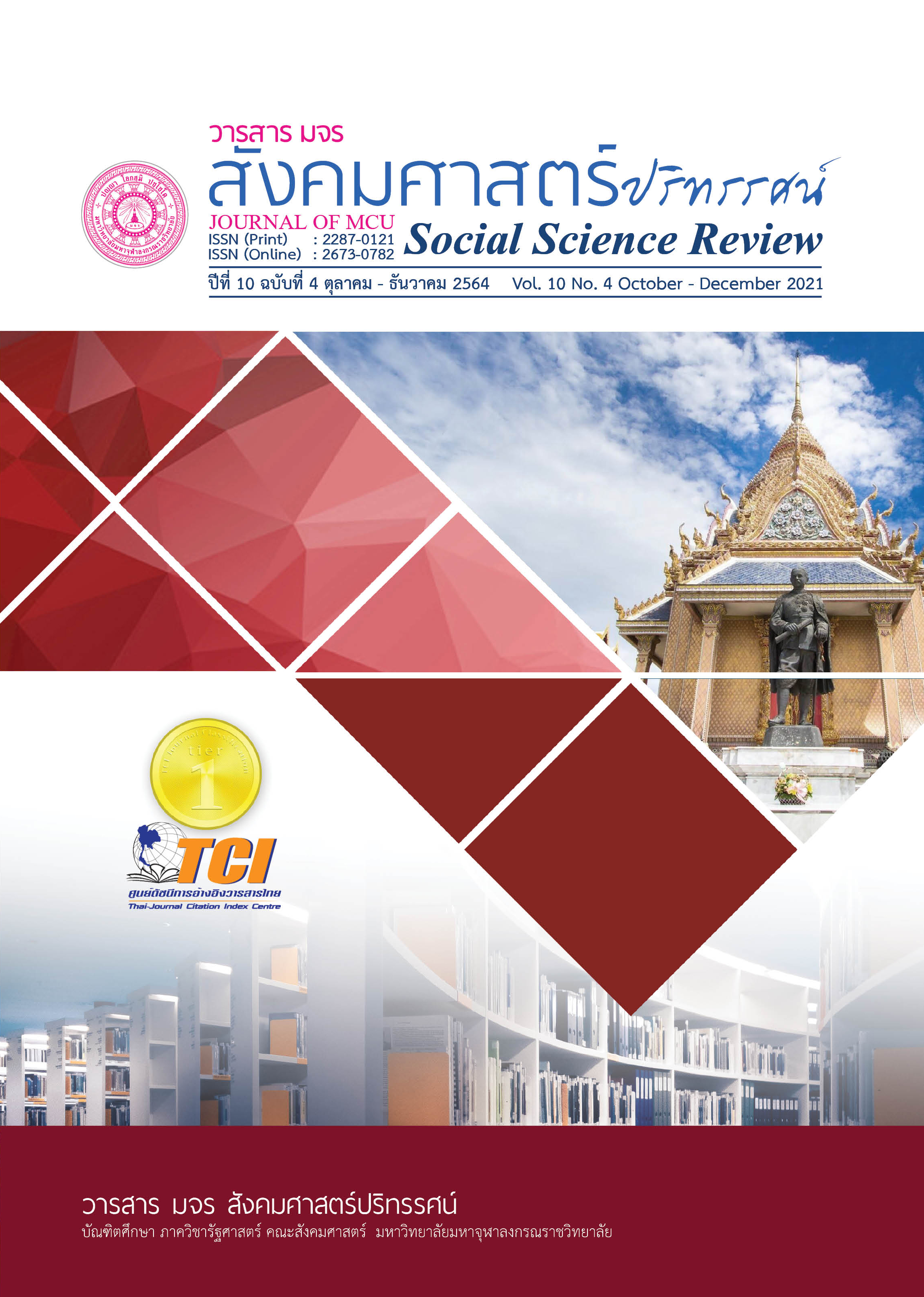รูปแบบการนำหลักพุทธธรรมมาใช้ในการบริหารจัดการการท่องเที่ยว เชิงอนุรักษ์ของชุมชนในจังหวัดสมุทรสงคราม
คำสำคัญ:
หลักพุทธธรรม, การบริหารจัดการ, การท่องเที่ยวเชิงอนุรักษ์บทคัดย่อ
บทความวิจัยนี้มีวัตถุประสงค์เพื่อศึกษา สภาพทั่วไป การนำหลักพุทธธรรมมาประยุกต์ใช้ และรูปแบบการนำหลักพุทธธรรมมาใช้ในการบริหารจัดการการท่องเที่ยวเชิงอนุรักษ์ของชุมชนในจังหวัดสมุทรสงคราม เป็นการวิจัยเชิงคุณภาพ
ผลการวิจัยพบว่า 1) สภาพทั่วไป ได้แก่ มีทรัพยากรธรรมชาติและสิ่งแวดล้อมที่เอื้อต่อการสร้างอาชีพหรือรายได้จากการท่องเที่ยว และกระแสการท่องเที่ยวเชิงอนุรักษ์กำลังได้รับความสนใจจากนักท่องเที่ยว เป็นต้น (2) หลักพุทธธรรมมาใช้ในการบริหาร ครอบคลุมหลักการปฏิบัติวิถีพุทธที่ส่งเสริมการประกอบสัมมาอาชีพและการดำเนินชีวิต ใน 4 ด้าน ได้แก่ ด้านอุฏฐานสัมปทา ด้านอารักขสัมปทา ด้านกัลยาณมิตตตา และด้านสมชีวิตา และ 3) รูปแบบการนำหลักพุทธธรรมมาใช้ในการบริหารจัดการการท่องเที่ยวเชิงอนุรักษ์ของชุมชนในจังหวัดสมุทรสงคราม คือ 4G-1P-3A Model หรือรูปแบบ 4 ภาคี 1 หลักการ 3 ขั้นตอน โดย 4G หรือ 4 ภาคี คือ ภาคีเครือข่ายผู้มีส่วนได้ส่วนเสีย 1P หรือ 1 หลักการ คือ หลักทิฏฐธัมมิกัตถประโยชน์ และ 3A หรือ 3 ขั้น ประกอบด้วย A1: Awareness คือ ความตระหนักรู้บทบาท ความตระหนักรู้หน้าที่ ความตระหนักรู้รักสามัคคี A2: Activity คือ กิจกรรมปลูกฝังจิตสำนึกการเป็นเจ้าบ้านที่ดี กิจกรรมรักษามาตรฐานในการให้บริการที่มีคุณภาพ กิจกรรมการให้บริการด้วยความเป็นมิตร กิจกรรมการให้บริการด้วยความซื่อสัตย์และไม่เอารัดเอาเปรียบ โดยมี A3: Achievement คือ ความสัมฤทธิ์ผลหรือความสำเร็จของการสร้างจิตสำนึกในการอนุรักษ์แก่ชุมชน ความสำเร็จของการสร้างความพึงพอใจแก่นักท่องเที่ยว และความสำเร็จของการสร้างความมีส่วนร่วมของผู้มีส่วนเกี่ยวข้อง หรือเรียกว่า “จิตสำนึกดี-มีความพอใจ-ได้มีส่วนร่วม”
เอกสารอ้างอิง
จุฑาธิปต์ จันทร์เอียด และคณะ. (2559). การพัฒนารูปแบบการท่องเที่ยวเชิงนิเวศโดยจักรยานของชุมชนบางพลับ อำเภอบางคนที จังหวัดสมุทรสงคราม. วารสาร ธุรกิจปริทัศน์, 8(2), 98-100.
พระครูพิมลธรรมภาณ (มานพ กนฺตสีโล). (2561). การบริหารการจัดการการท่องเที่ยวเชิงวัฒนธรรมของวัดพระเชตุพนวิมลมังคลารามราชวรมหาวิหาร. วารสารสหวิทยาการนวัตกรรมปริทรรศน์, 1(2), 11-21.
พระครูพิศิษฏ์ประชานาถ (ประยูร นนฺทิโย). (2563). สภาพทั่วไปการมีส่วนร่วมของพระสงฆ์ในการพัฒนาชุมชนจังหวัดสมุทรสงคราม. วารสารสหวิทยาการนวัตกรรมปริทรรศน์, 3(2), 50-59.
พระมารุต กิตฺติปาโล. (2564). บทบาทพระสงฆ์ในการพัฒนาชุมชนอำเภอชะอำ จังหวัดเพชรบุรี. วารสารพุทธนวัตกรรมและการจัดการ, 4(1), 18-27.
พระแมนรัตน์ จตฺตมโลและคณะ. (2562). การพัฒนาวัดเพื่อการท่องเที่ยวเชิงวัฒนธรรม อำเภอบางคนที จังหวัดสมุทรสงคราม. วารสารสหวิทยาการนวัตกรรมปริทรรศน์, 2(2), 24-33.
พระอนพัทย์ ฐิตธมฺโม. (2564). การส่งเสริมความสมานฉันท์ตามแนวพระพุทธศาสนาสำหรับชุมชนของวัดพระนารายณ์มหาราชวรวิหาร จังหวัดนครราชสีมา. วารสารสหวิทยาการนวัตกรรมปริทรรศน์, 4(1), 22-31.
เพียงฤทัย เสงี่ยมศิลป์ และคณะ. (2561). การศึกษาแนวทางการส่งเสริมการท่องเที่ยวเชิงเกษตรของพื้นที่ ตาบลวังยาง อำเภอศรีประจันต์ จังหวัดสุพรรณบุรี (รายงานวิจัย). สุพรรณบุรี : มหาวิทยาลัยเทคโนโลยีราชมงคลสุวรรณภูมิ.
วิทยา จันทร์แดง. (2555). การพัฒนารูปแบบการบริหารจัดการชุมชนเข้มแข็งตามแนวปรัชญาเศรษฐกิจพอเพียงในเขตจังหวัดภาคกลางตอนบน (วิทยานิพนธ์รัฐประศาสนศาสตรดุษฎีบัณฑิต สาขาวิชารัฐประศาสนศาสตร์). กรุงเทพฯ: มหาวิทยาลัยราชภัฎวไลยอลงกรณ์ในพระบรมราชูปถัมภ์.
ศรัญญา ศรีทอง. (2559). การพัฒนารูปแบบการจัดการการท่องเที่ยวเชิงเกษตรโดยชุมชน. (วิทยานิพนธ์วิทยาศาสตรดุษฎีบัณฑิต สาขาวิชาวิทยาศาสตร์การกีฬา). กรุงเทพฯ : จุฬาลงกรณ์มหาวิทยาลัย.
สภาอุตสาหกรรมการท่องเที่ยวแห่งประเทศไทย (สทท.). (2561). ดัชนีความเชื่อมั่นผู้ประกอบธุรกิจการท่องเที่ยวในประเทศไทย ไตรมาสที่ 4 ปี 2561. กรุงเทพฯ : สภาอุตสาหกรรมการท่องเที่ยวแห่งประเทศไทย (สทท.).
สมชาย ลำภู. (2563). การพัฒนาชุมชนตามแนวพระพุทธศาสนาในตำบลเหมืองใหม่ อำเภออัมพวา จังหวัดสมุทรสงคราม. วารสารพุทธนวัตกรรมและการจัดการ, 3(2), 59-67.
ดาวน์โหลด
เผยแพร่แล้ว
รูปแบบการอ้างอิง
ฉบับ
ประเภทบทความ
สัญญาอนุญาต
ลิขสิทธิ์ (c) 2021 วารสาร มจร สังคมศาสตร์ปริทรรศน์

อนุญาตภายใต้เงื่อนไข Creative Commons Attribution-NonCommercial-NoDerivatives 4.0 International License.
เพื่อให้เป็นไปตามกฎหมายลิขสิทธิ์ ผู้นิพนธ์ทุกท่านต้องลงลายมือชื่อในแบบฟอร์มใบมอบลิขสิทธิ์บทความให้แก่วารสารฯ พร้อมกับบทความต้นฉบับที่ได้แก้ไขครั้งสุดท้าย นอกจากนี้ ผู้นิพนธ์ทุกท่านต้องยืนยันว่าบทความต้นฉบับที่ส่งมาตีพิมพ์นั้น ได้ส่งมาตีพิมพ์เฉพาะในวารสาร มจร สังคมศาสตร์ปริทรรศน์ เพียงแห่งเดียวเท่านั้น หากมีการใช้ภาพหรือตารางหรือเนื้อหาอื่นๆ ของผู้นิพนธ์อื่นที่ปรากฏในสิ่งตีพิมพ์อื่นมาแล้ว ผู้นิพนธ์ต้องขออนุญาตเจ้าของลิขสิทธิ์ก่อน พร้อมทั้งแสดงหนังสือที่ได้รับการยินยอมต่อบรรณาธิการ ก่อนที่บทความจะได้รับการตีพิมพ์ หากไม่เป็นไปตามข้อกำหนดเบื้องต้น ทางวารสารจะถอดบทความของท่านออกโดยไม่มีข้อยกเว้นใดๆ ทั้งสิ้น





